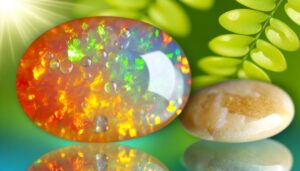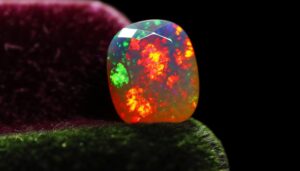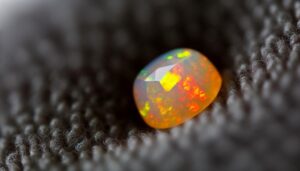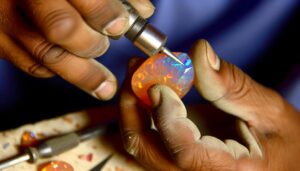Does a Green Opal Have Fire?
Green opal doesn't have the 'fire' that you'll find in precious opals. Instead, it lacks the play-of-color caused by the diffraction of light in ordered silica spheres.
Green opal forms from silica-rich solutions and gains its hue from trace elements like iron or nickel. Its value comes from its aesthetic appeal rather than optical phenomena.
If you explore further, you'll understand the differences in geological formation and optical properties that set green opals apart.
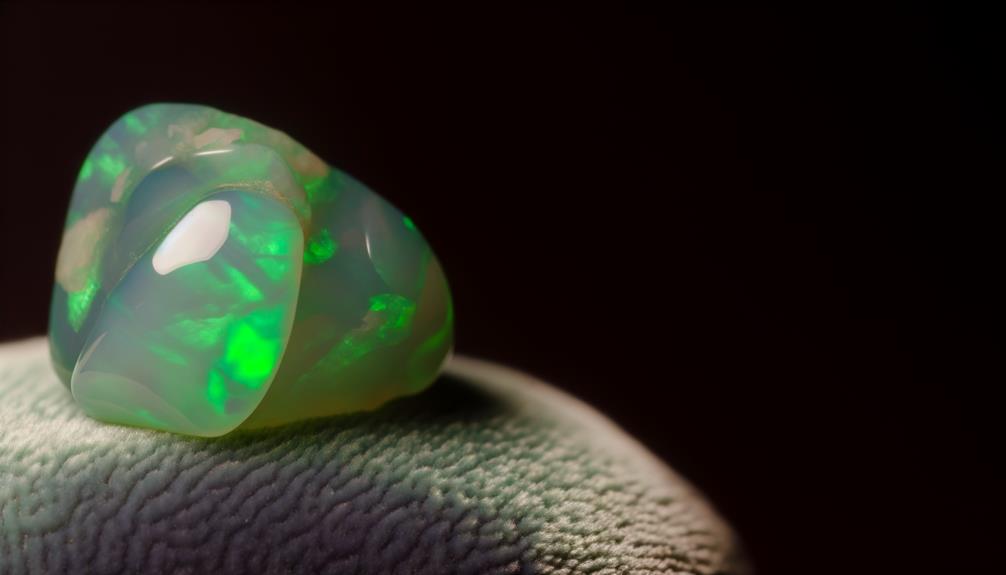
Key Takeaways
- Green opal lacks the play-of-color, or "fire," characteristic of precious opals.
- The color in green opal is due to trace elements like iron or nickel, not light diffraction.
- Green opal's visual appeal comes from its steady green hue rather than optical phenomena.
- Unlike precious opals, green opals do not exhibit a kaleidoscope of colors from silica spheres.
- Green opal's value is based on aesthetic appeal rather than the presence of fire.
What Is Green Opal?
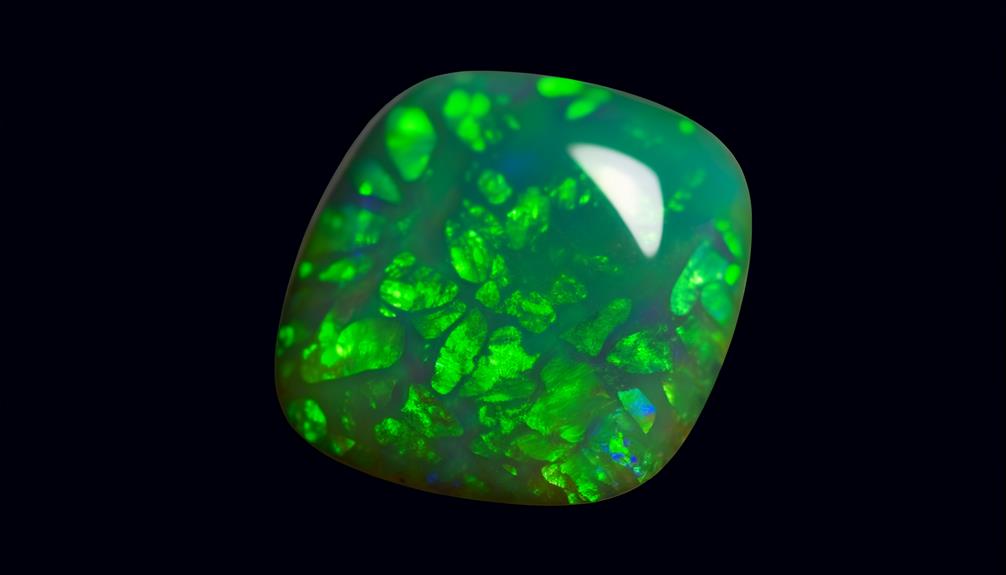
Green opal, a subvariety of common opal, frequently exhibits a range of green hues due to trace amounts of minerals such as iron or nickel.
You'll notice that green opal doesn't display the play-of-color seen in precious opals. Instead, its allure stems from its uniform and sometimes translucent green coloration.
This material typically has a Mohs hardness of 5.5 to 6, making it suitable for various types of jewelry but requiring care to avoid scratches.
Unlike precious opals, green opal's value is derived more from its aesthetic appeal and less from any optical phenomena.
When evaluating green opal, you should focus on color uniformity, translucency, and the absence of inclusions for the best quality specimens.
Formation of Green Opal
To understand green opal's formation, you must examine its geological formation process and mineral composition.
This opal forms when silica-rich solutions fill cavities in rocks, gradually hardening over time.
The green hue results from trace elements like iron or nickel within the mineral structure.
Geological Formation Process
The formation of green opal involves the intricate process of silica deposition in a gel-like form, often within the voids of sedimentary rocks. You'll find that this silica-rich gel gradually hardens and undergoes a process called polymerization.
Water plays a vital role, transporting silica into these voids and facilitating the gel formation. Over time, the gel dehydrates and solidifies, creating opal. Trace elements and minerals, such as iron or nickel, can enter this gel, imparting the green hue you see in green opals.
The conditions must remain stable for millions of years to allow for the opal's maturation. Understanding this geological process highlights the delicate balance and precise conditions required for green opal to form naturally.
Mineral Composition Factors
Understanding the mineral composition factors influencing green opal formation requires analyzing the trace elements and impurities that contribute to its unique coloration. You need to take into account the presence of minerals like iron, nickel, and chromium, which are essential in creating the green hues.
Iron can produce a range of green shades, depending on its oxidation state. Nickel can induce a vibrant green, while chromium often results in a deeper, more intense green. Additionally, the water content within the opal matrix plays a significant role in its overall appearance.
Variations in these elements and their concentrations directly impact the opal's color intensity and distribution. By examining these factors, you can gain a thorough understanding of what makes green opal distinct.
Green Opal Vs. Other Opals

When comparing green opal to other opals, you'll notice distinct differences in color and transparency. Green opals often exhibit unique fire characteristics that set them apart from their counterparts.
Analyzing these aspects helps you understand the specific allure and value of green opals in the gemstone market.
Color and Transparency Differences
Green opal exhibits unique color and transparency characteristics that distinguish it from other opals. When you examine green opals, you'll notice they often display a semi-translucent to opaque quality, unlike the more transparent nature of precious opals.
The green hue typically arises from the presence of nickel or iron within the silica structure. In contrast, other opals, such as black or white opals, derive their colors from different impurities and structural arrangements.
Black opals, for example, have a dark body tone that enhances color play, while white opals have a milky appearance due to microscopic inclusions. Understanding these differences helps you appreciate the distinct visual appeal and material properties of green opal compared to its opal counterparts.
Unique Fire Characteristics
Unlike other opals, green opal typically lacks the vibrant play-of-color known as 'fire,' which results from the diffraction of light within the silica spheres. Instead, green opal's beauty lies in its consistent, translucent to opaque green hue.
In contrast, precious opals exhibit a kaleidoscope of colors due to their highly ordered silica structure. This structural difference means you won't see the same spectral phenomenon in green opals. However, green opals do possess a unique charm due to their rich color, often enhanced by natural inclusions.
When comparing, remember that while precious opals dazzle with their fire, green opals offer a steady, earthy beauty that's equally enchanting in a different way.
The Concept of Fire in Opals
Fire in opals refers to the play of color caused by the diffraction of light within the microstructure of silica spheres.
When you observe opals, you'll notice a brilliant display of colors that seem to change with the angle of light. This phenomenon is technically known as 'play of color.'
To better understand, consider these key points:
- Silica Spheres Arrangement: Tiny, uniform silica spheres create a grid that diffracts light.
- Light Diffraction: The light splits into various colors as it passes through the gaps between spheres.
- Color Variation: The size and arrangement of these spheres determine the color spectrum.
- Angle of Viewing: The angle at which you view the opal affects the visible colors.
Understanding these principles helps you appreciate the mesmerizing fire in opals.
Optical Properties of Green Opal
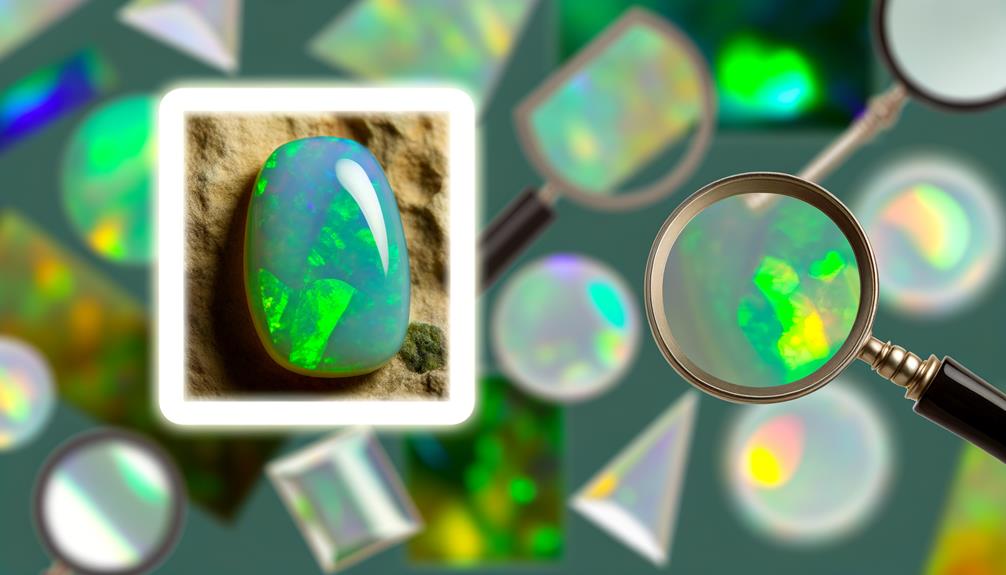
You'll find that the optical properties of green opal are primarily influenced by its unique internal structure and the way it interacts with light.
The internal arrangement of silica spheres within the opal causes diffraction, leading to a phenomenon known as 'play-of-color.' This diffraction results in the display of vibrant greens and other spectral colors when light passes through or reflects off the opal's surface.
The size and uniformity of these silica spheres directly impact the intensity and quality of the colors observed.
When evaluating green opal, consider both transparency and the quality of the play-of-color, as these factors notably influence its overall visual appeal. Understanding these properties helps you appreciate the gem's inherent beauty and complexity.
Chemical Composition
When you examine the chemical composition of green opal, you'll find it primarily consists of hydrated silica.
Trace elements like iron and nickel contribute to its unique coloration.
Additionally, its structural properties, such as the arrangement of silica spheres, play an essential role in its optical characteristics.
Mineral Elements Found
Green opal primarily consists of hydrated silica, but its chemical composition can also include trace elements like iron, nickel, and chromium. These trace elements contribute to the stone's distinctive green hue and can influence its overall appearance.
To better understand green opal's composition, consider the following key points:
- Hydrated Silica (SiO2·nH2O): The primary component, forming the opal's base structure.
- Iron (Fe): Often present in small amounts, this element can enhance the green coloration.
- Nickel (Ni): Adds to the hue variation, giving green opal its unique shade.
- Chromium (Cr): Known for its intense coloring properties, it contributes significantly to the green pigment.
Unique Structural Properties
In examining green opal's unique structural properties, you'll find that its internal lattice lacks the regular crystalline structure seen in other minerals. Instead, green opal's composition is amorphous, consisting of hydrated silica (SiO₂·nH₂O).
This lack of crystallinity results from the random arrangement of silica spheres within the opal. The size and distribution of these spheres cause the characteristic play of color, or 'fire,' observed in opals.
Green opal's water content can range from 3-21%, influencing its transparency and color intensity. The presence of trace elements like iron and nickel can further modify its hue.
Mining Locations
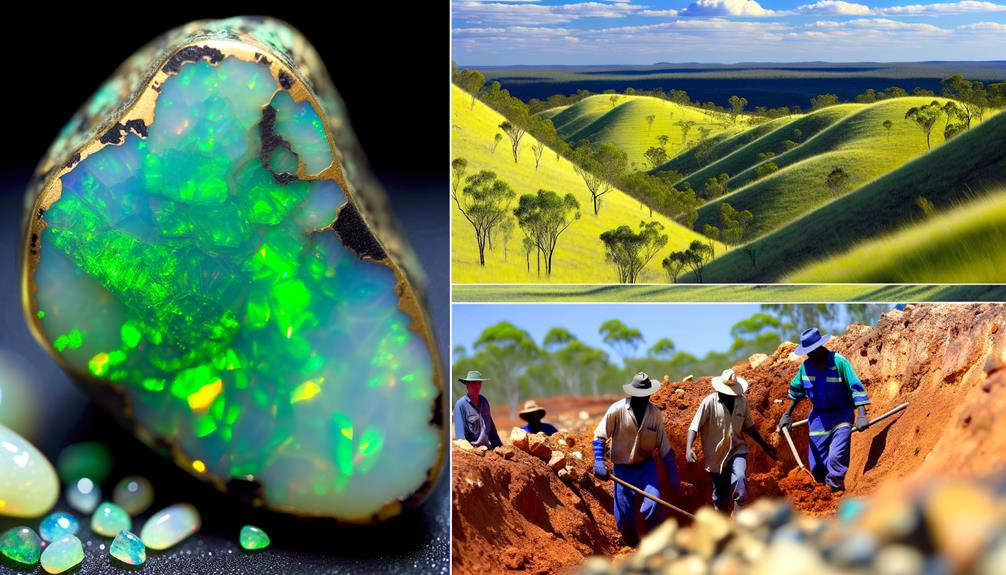
Several key regions around the world are renowned for their rich deposits of green opal.
You'll find these opal mines primarily in:
- Australia – Specifically the Mintabie and Coober Pedy regions, known for producing high-quality opals with vibrant green hues.
- Brazil – The deposits in the Piaui region are famous for their deep green opals.
- Ethiopia – Welo opal fields have recently gained attention for their unique green opal varieties.
- United States – Nevada and Oregon offer green opals, though in lesser quantities compared to Australia and Brazil.
Each location has distinct geological conditions that contribute to the formation and unique characteristics of green opal, making these regions critical for sourcing this enchanting gemstone.
Gemstone Grading
When grading green opal, gemologists assess several critical factors, including color intensity, clarity, cut, and the presence of any play-of-color or fire. Each factor contributes to the gemstone's overall value and appeal. Color intensity should be vibrant and evenly distributed. Clarity involves examining the opal for inclusions or imperfections. A well-executed cut enhances the gem's natural beauty and maximizes light reflection. The presence of play-of-color or fire, characterized by flashes of spectral colors, notably boosts the opal's desirability.
| Grading Factor | Description |
|---|---|
| Color Intensity | Vibrant, evenly distributed color |
| Clarity | Absence of inclusions or imperfections |
| Cut | Precision in shaping; enhances light |
Understanding these grading criteria helps in evaluating the true worth of a green opal.
Green Opal in Jewelry
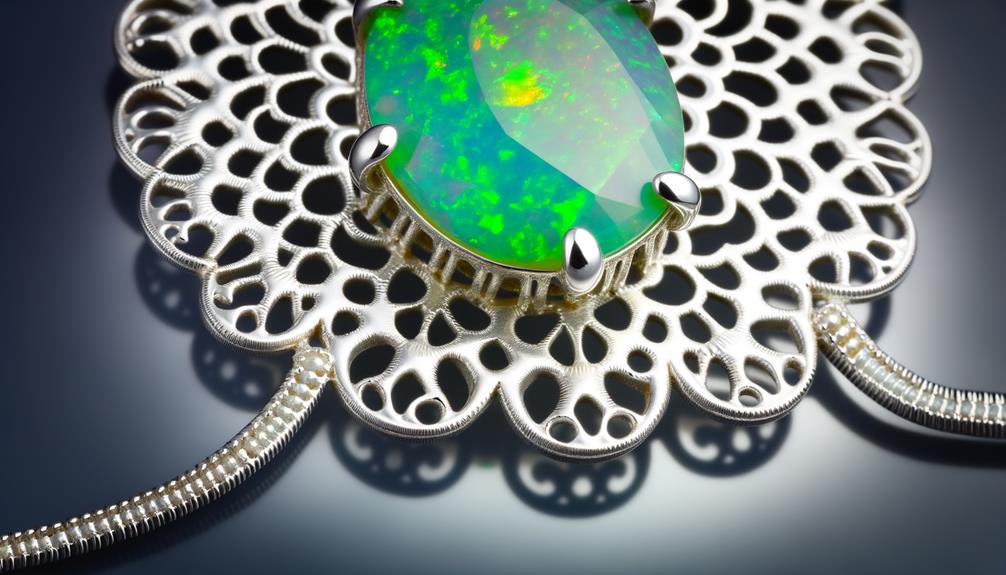
Green opal's distinctive shade and potential play-of-color make it an enchanting choice for statement jewelry pieces. When you're selecting green opal jewelry, it's essential to ponder several key factors:
- Color Consistency: Confirm the hue is consistent across the stone, enhancing its visual appeal.
- Clarity: Seek minimal inclusions, as these can diminish from the stone's beauty and durability.
- Cut: A well-executed cut maximizes the opal's play-of-color, enhancing its overall brilliance.
- Setting: The setting should complement the opal, providing security without overshadowing the stone's natural beauty.
Healing Properties
Exploring the healing properties of green opal, you'll find it reputed for enhancing emotional recovery and fostering a sense of tranquility. This gemstone is believed to balance your emotions, mitigating stress and anxiety. By promoting emotional stability, green opal can potentially aid in overcoming past traumas. It's also thought to encourage personal growth and resilience.
Analytically, green opal interacts with the heart chakra, which is associated with love and compassion. This alignment may enhance your capacity for empathy and emotional understanding. Moreover, it's said to support detoxification processes, both physically and energetically. Green opal's calming influence can foster a meditative state, facilitating mental clarity.
Care and Maintenance
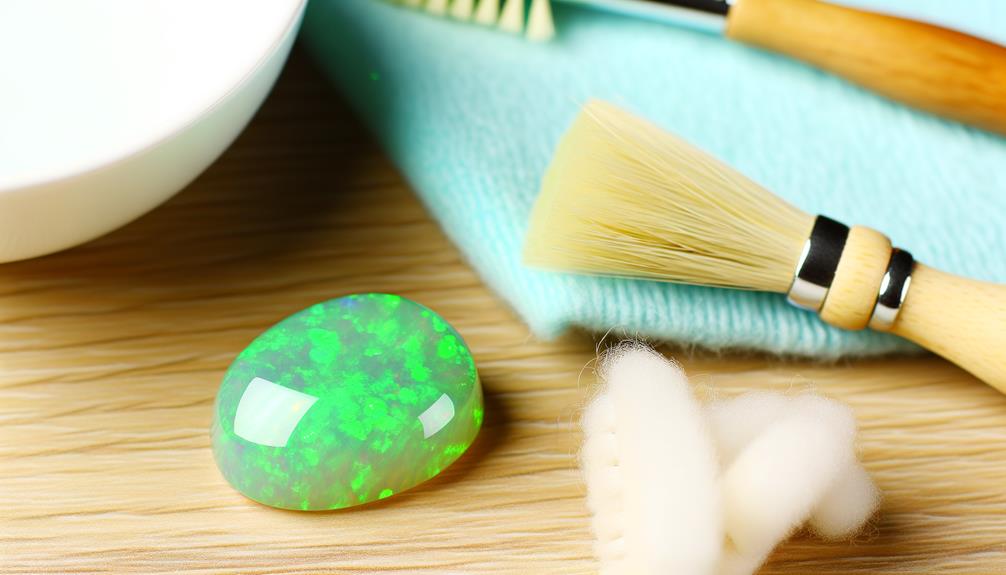
Proper care and maintenance of green opal are crucial to preserve its beauty and healing properties. To maintain your green opal in its best condition, follow these steps:
- Avoid Exposure to Direct Sunlight: Prolonged exposure can lead to the opal cracking or fading.
- Limit Contact with Water: Excessive moisture can compromise the stone's structure.
- Store Properly: Keep your opal in a gentle cloth or cushioned jewelry box to prevent scratches.
- Clean Gently: Use a gentle, damp cloth to clean the opal, avoiding harsh chemicals and ultrasonic cleaners.
Authenticity and Imitations
When determining the authenticity of green opal, you must closely examine its internal structure and color consistency to differentiate it from imitations. Authentic green opals exhibit a uniform color distribution and a distinctive play of color, or 'fire,' within their matrix. This fire is a key indicator of genuine opal.
Imitations, often made from glass or plastic, lack this dynamic quality and typically show bubbles or an overly uniform appearance under magnification. Use a loupe to inspect for these imperfections.
Additionally, genuine opals have a unique hydrophane property, absorbing water and temporarily changing transparency. Knowing these characteristics helps you accurately assess the authenticity, ensuring you avoid synthetic or treated stones that might deceive the untrained eye.
Conclusion
To sum up, green opals are distinctive gemstones with their own collection of remarkable qualities, though they lack the intense sparkle seen in some other opals. Their understated appeal and healing advantages make them a cherished possession.
When selecting green opal jewelry, make sure to provide adequate care to preserve its charm. Remember, it's essential to confirm authenticity to steer clear of counterfeits.
With green opal, you're not just acquiring a gem; you're capturing lightning in a bottle.

